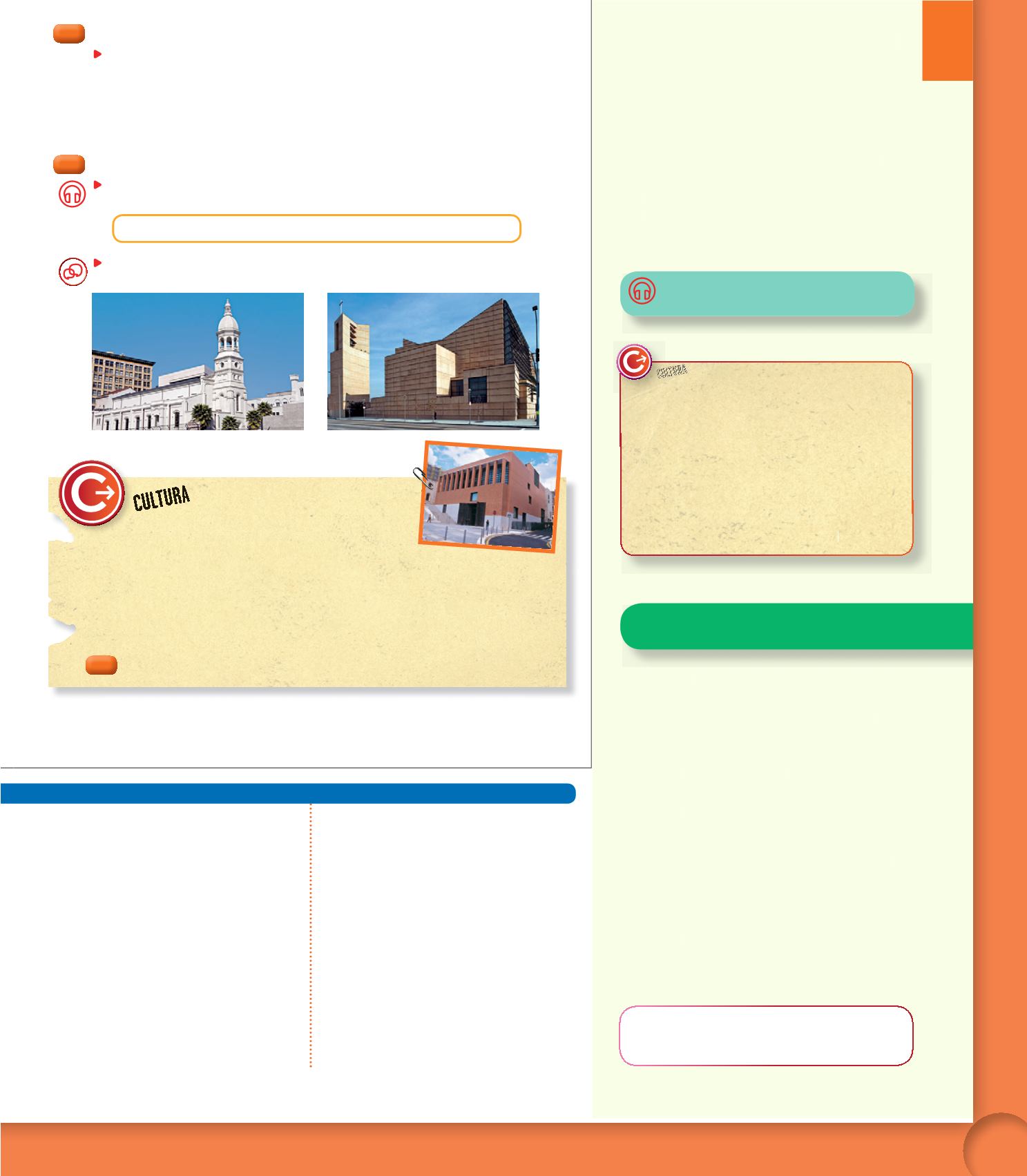

85
Opinar y hacer valoraciones
DESAFÍO 2
Unit
6
HERITAGE LANGUAGE LEARNERS
r
Explain to students that Spanish missions
played an important role in the history of the
United States, especially in the southwest.
Ask students to research this role, and
include some of the history of the missions,
the characteristics of their structures, their
purpose, and the impact the missions had
on the indigenous populations. Invite
students to make a presentation before the
class based on their research. Encourage
students to accompany their presentations
with images of some of the better-known
missions, especially those along
el
Camino Real
.
CRITICAL THINKING
r
If students were doing a digital tour of an
interesting structure or building in their
community, ask them which one they would
select and why. After discussing this in small
groups, have groups make a final selection,
and justify their choices. Students should
also explain how they would start their tour:
with a brief history of the community, a short
biographical sketch of the architect, or some
other strategy to get viewers’ attention. After
all groups make their presentations, have
the class select the definitive landmark for
their tour.
35.
To extend this activity, have students write two
or three questions for Rafael Moneo about
architecture and its role in society. Ask
volunteers to pretend to be Moneo and sit on
the “hot seat” and rapidly answer questions
posed by the class.
AUDIO SCRIPT
See page 297L.
Answer Key
32.
1. es
3. sea
2. tiene
4. debamos
▶
1.–2. indicativo: opinión afirmativa
3.–4. subjuntivo: opinión en negativo
33.
Answers will vary. Sample answers:
1. En preparar un
tour
digital de la catedral
de Los Ángeles.
2. Es original. Daniel dice: «no se parece
a ninguna de las que he visto».
3. Comenzarán hablando del arquitecto.
4. No le gusta hablar frente a la cámara,
pero a Michelle sí le gusta.
5. Answers will vary.
34.
Answers will vary.
▶
Answers will vary.
35.
Answers will vary.
3
3
¿Comprendes?
Responde
a estas preguntas.
1.
¿En qué consiste el desafío de Michelle y Daniel?
2.
¿Cómo es la catedral de Los Ángeles? ¿Qué palabras del diálogo justifican tu respuesta?
3.
¿Con qué contenido van a empezar el
tour
digital?
4.
¿Qué no le gusta hacer a Daniel? Compara su actitud con la de Michelle.
5.
¿Por qué crees que Moneo se inspiró en las antiguas misiones al diseñar esta catedral?
3
4
La catedral de Los Ángeles
Escucha
la conversación entre Michelle y Daniel mientras visitan la catedral.
Después, escribe un resumen usando estas palabras.
exterior terremoto luz diseñar reflejar diversidad construir
Habla
con tu compañero(a). Comparen la antigua catedral de Los Ángeles y la nueva
diseñada por Moneo. ¿Cuál les gusta más? ¿Por qué? Compartan sus opiniones con la clase.
Rafael Moneo
Rafael Moneo nació en España en 1937. Siempre ha combinado
sus dos pasiones: la arquitectura y la enseñanza. Desde 1985
hasta 1990, fue decano de la facultad de Arquitectura de Harvard.
La mayor parte de sus obras se encuentran en España, Suecia y los Estados Unidos.
En 1996 recibió el Premio Pritzker, considerado el Premio Nobel de la arquitectura
porque se entrega a arquitectos que hayan realizado construcciones funcionales
de buena calidad, con un alto nivel de creatividad y que contribuyan al enriquecimiento
de la humanidad.
5
3
Piensa y explica.
Para ti, ¿cómo puede enriquecer un edificio a la humanidad?
Museo del Prado (Madrid).
Additional Resources
Fans Online activities
Rafael Moneo
Rafael Moneo believes that architecture is an
art that is capable of communicating as much
as a song, a painting, or a sculpture. Before
designing a building, he considers its location
carefully, which is the reason his buildings are
extremely site-specific—as if woven into the
landscape. This approach produces buildings
that are understated, yet functional.
ULTURA
C
317
Book 4 Unit 6


















